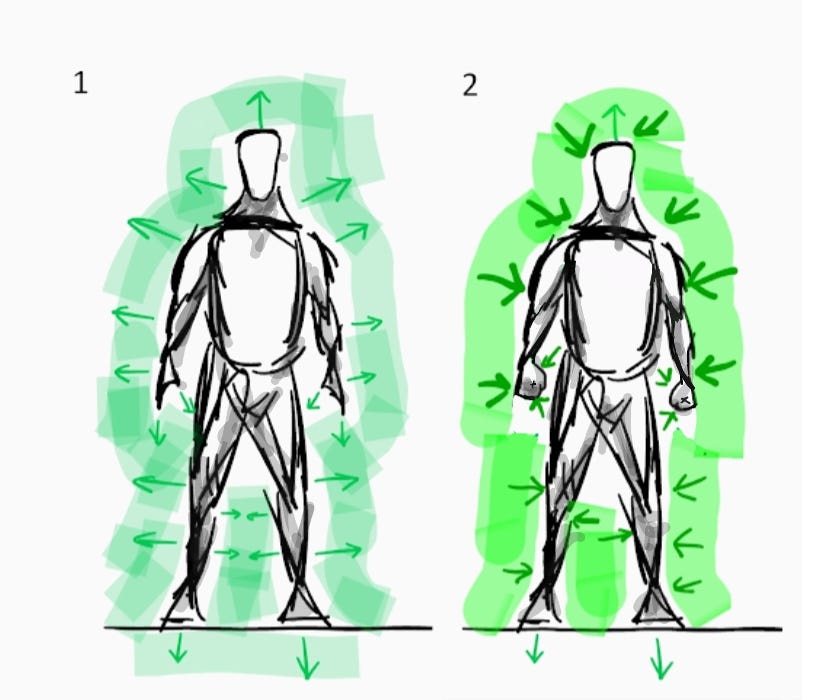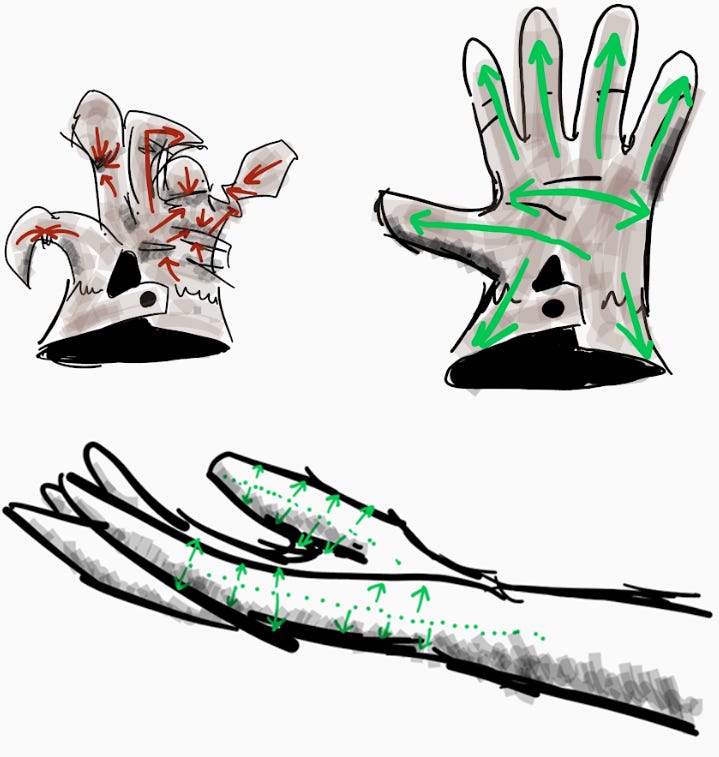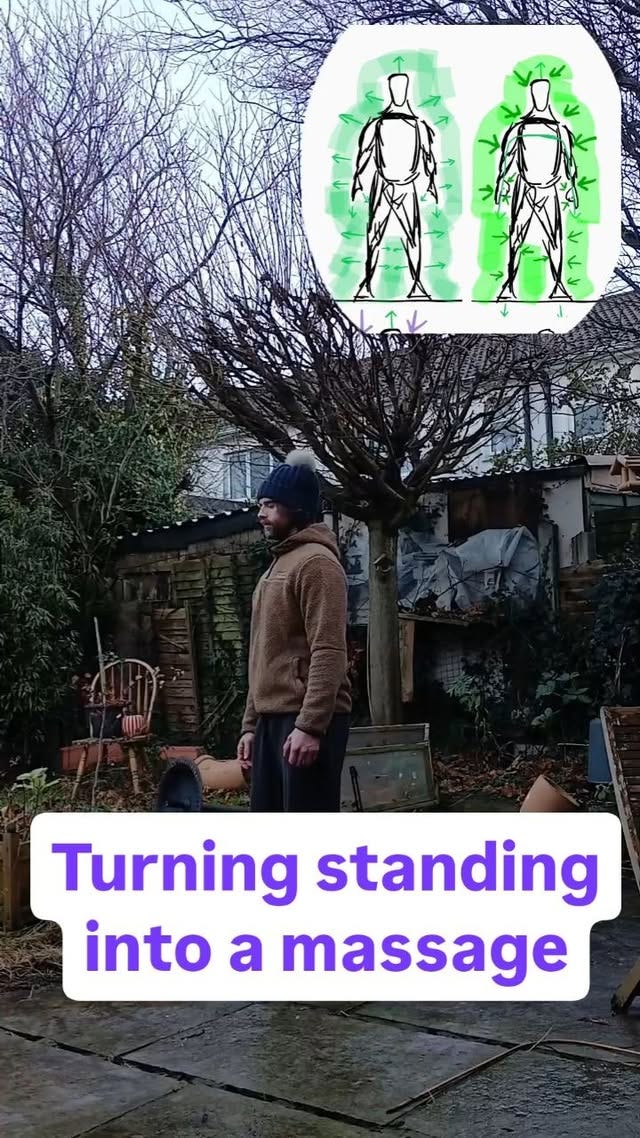Be still like tree, not like statue
Foreword
This piece was inspired by a conversation I had with a friend of mine. He was telling me about how the teacher he did the standing work with talked about ignoring urges to move, forcing yourself to be absolutely still. Which I found appallingly short-sighted. I think it is much more nourishing to allow some movement in your stillness.
Even a tree moves
The meditation and stillness practices (lying, kneeling, seated, zhan zhuang), in my opinion, is not about forcing yourselves to be a statue. Treating standing purely as a practice of discipline and will-power is a limiting disservice to it. This might feel like resilience, but it’s a rigid and fragile thing, that relies on you pushing and fighting the tensions and urges to move that you feel. These habits can lead to a numbing or dissociation, that mean you could miss early signs of illness, unease and exhaustion.
Instead, it's about [eventually] [at some indeterminate point in the future] arriving at a state of quasi-stillness. There’s always some motion. Nothing living is truly still. Even in stillness, there is movement if you watch closely. These organic processes unfolding and emerging over time. Like motions of an oak; its branches shifting in the breeze, lifting as the sun rises, drooping as it sets,1 as the seasons change — leaves coming and going.
In my standing practice and classes, instead of ignoring, fighting, suppressing the spontaneous movements, we ask: how can we respond to them — these impulses to shift and adjust? How can we move in centimeters, even millimeters, that help remove tension?
This adds a critical depth to stillness practice, which might seem counter-intuitive at first, but it is something that will allow your stillness to evolve; as you interpret the tension in your body as a sign to move and soften, instead of fighting it. The shape and tone of your body can change, instead of being stagnant and fixed.
Anecdotal evidence
I had client doing their first session with me and we began with some lying work, as they were relaxing and settling, they began to cry. They were holding onto something that hurt them earlier in the week. It had been there underneath the busyness of the week. It shocked her, that she had held on to it for so much time and hadn’t realised it. I’ve had similar experiences.
Earlier this year, I had an issue at work that I let fester for a couple of days, and it was only when I made time to lie down and reflect on what I was holding and my anxiety about it came up. As I acknowledged it and accepted that the anxiety was there, it softened and lessened. It was a weight off of my chest when it happened, but I did feel exhausted by it, because I had been in a low level in fight-flight the days I had been ignoring it.
I only just heard a wonderful voice note from a friend of mine marvelling at how much energy he has after working a string of 8 to 12 hour shifts at his work because he’s made a habit of noticing for the tension during his day and then softening or lessening it as in the first exerise. He sounded overjoyed with this breakthrough because he used to be exhausted from his work, especially the longer shifts and it took him a lot of effort to mentally prepare for his work and to do other things afterwards.
These are some examples about why it is so powerful to permit yourself to let go and to use the “stillness” practices to allow these things to come loose and pass through. These little motions are reorganising, re-distributing or releasing strains and tensions.
This is why I encourage people to honor their need for movement, to avoid feeling trapped or stuck. Over time—whether within a single session or across months and years—as you move imperceptibly and increase your sensitivity, you can arrive at a state of stillness. I believe this is a fascinating journey: teasing apart the spectrum of sensations you experience. Which sensations are calling for release? As you stand, you might find deep-seated tension tied to a difficult memory or pain that needs to be processed and released. How do you respond the sensations, the pressures, the pulls and pushes inside of you?
If you’re looking for guidance on recognizing your body’s subtle signals for movement and release, here are some exercises I recommend:
Exercise 1: inquiry
I’ve mentioned this before in previous posts, but I’ll gladly repeat myself about it. It’s most useful to start this in lying, because it is minimal effort, but once the process is clear you can do it while sitting, standing, walking, etc.
Allow your mind to wander for a bit, undirected, unconstrained, like a dog nosing around the room before it settles down to sleep
When you remember, ask one of this questions:
What are you holding?
What are you holding up, that wants to sink into the ground?
What are you holding down that wants to rise into the air?
What are you holding in that wants to expand outwards?
What are you holding out that wants to condense inwards?
Let the question hang there and notice where your attention goes in your body.
Can you soften your hold, or even let go of it completely?
When you remember ask on of the questions again and allow the process to go again. Repeat until you’ve had your fill of it.
Emotions can come up — sorrow, anger, fear, … . It can happen that you’re eyes water and weep, not even emotionally, but almost like a purging. Also this isn’t like a strict meditation practice where you are constantly trying to maintain your focus or concentration. It’s unforced and organic. I like to use the cue of “when you remember to, then … .” Allow your mind to wander. Ask a question when you feel like it. Appreciate where your awareness is drawn.
Exercise 2: Body Breathing
This is a fundamental qigong/neigong exercise that fits wonderfully into stillness practices (lying, kneeling, standing whichever way). It can be like a wonderful massage for the body. Check me out modelling it below.2
Stand in any pose you like. Begin by focusing on your center of gravity, located beneath your navel.
Imagine a sense of fullness expanding outward from there, creating space between your bones and joints.
Feel this expansion traveling upward through your organs, chest, and shoulders. Visualize your shoulder blades sliding outward, your shoulder joints opening, and the space in your pelvis expanding; in time with this your hands being pushed open.
Let this expansion flow all the way to your toes, fingertips, neck, jaw, and the crown of your head.
When the expansion reaches its endpoint, allow it to gently rest and return to your center; your hand in time compressing into a fist.
Repeat this process for a few minutes, expanding and condensing, while noticing any areas of tension or difficulty in your body.
After 5–10 minutes, ask yourself: How could I do this with 5% less mental effort? The goal is to learn how to communicate with your body gently and silently, almost like a soft whisper.

There shouldn’t be any strain in the expansion or condensation. Imagine the tissues, muscles, swelling/expanding and notice how the tissues respond to it. It can help to do it together with your breathing in the beginning - expanding as you inhale and condensing as you exhale. In my experience there’s quite an intuitive response in the body to imagining it expanding. You can try it with a specific part of your body initially, like your palm or your stomach. Also remember that there is a back to you as well, remember to allow the expansion and spreading of the tissues back there. Like you were a ball - everywhere feeling equal, no corners or parts of you sticking out. If it’s still confusing, leave a comment :)
Exercise 3: Fitting the Glove
This is a personal exercise I created, though it may overlap with ideas from other practitioners. This exercise is a gradual, organic journey through your body. The goal is to imagine how you can fit better within yourself—exploring subtle, spontaneous movements that help you release tension and feel more at ease.
Starting with your hands, hanging naturally at your sides or whatever position your pose requires.
Think of getting your hand inside a glove that has become wrinkled, twisted, and balled up in your pocket.
Consider the small adjustments your hand would make to smooth out the glove and fit yourself inside of it.
Imagine your hand is inside a glove—this glove represents your skin and fascia.
What small movements would your hand need to make to smooth out the wrinkles in this imaginary glove? Picture yourself gently spreading and untwisting the “fabric” of the glove, adjusting each joint and tissue in your hand until the glove fits perfectly.
Once this process feels settled in your hand, apply the same concept to your wrist, elbow, shoulder, chest, back, pelvis, and so on; If you can’t figure out how to apply it to a specific area, return to one you have already done.
Closing
Having tension and working against the tension consumes a lot of energy — parasitic tensions. Further you are building a habit of ignoring what you feel. It strikes me as disempowering. At it’s worst, it encourages you stay in difficult situations in your life without thinking you have power to change them, or at least to make them easier for yourself. You might be more likely to “do what you are told” even when it does not feel right for you, which has led to mass instances of abuse in yoga and martial arts schools, where the teachers insist on you pushing yourself and listening to them over yourself.
Permitting little changes, and releasing these parasitic tensions gives more and more energy and sensitivity; offering a more sustainable way of being. It helps strengthen your awareness, and better interpret what you can do to make your life easier. It builds you intuition and your trust in yourself.





